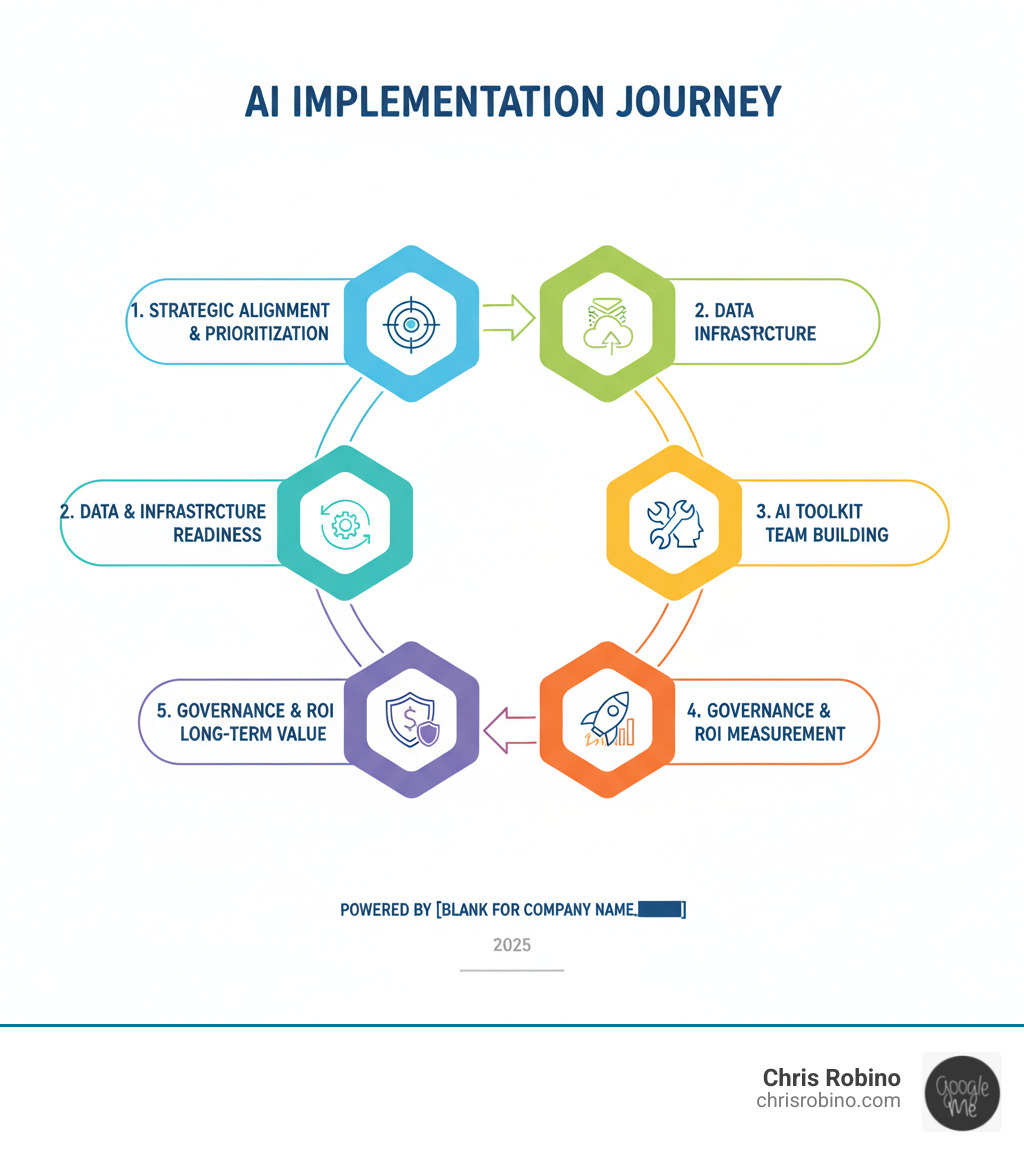Why AI Implementation Strategies Matter Now
AI implementation strategies are the structured approaches organizations use to adopt and scale artificial intelligence. AI has moved from an experimental technology to a strategic necessity, but the path is challenging. Research shows that 70% of AI projects fail, often due to a lack of strategic alignment and planning.
The problem isn’t a lack of technology; it’s disconnected implementation. Many companies launch isolated pilots that never scale or align with business goals. The solution is a phased, strategic approach that integrates AI with core objectives.
Core Components of Successful AI Implementation:
- Strategic Alignment – Connect AI initiatives to business objectives.
- Data Readiness – Ensure data quality, accessibility, and governance.
- Infrastructure Planning – Choose the right deployment models.
- Team Building – Develop AI-proficient teams.
- Deployment & MLOps – Test rigorously and plan for continuous improvement.
- Governance & Ethics – Establish frameworks for responsible AI and measure ROI.
This guide walks you through each phase of that journey. You’ll learn how to prioritize use cases, prepare your data, build teams, deploy with confidence, and establish governance for long-term value.
I’m Chris Robino, a Digital Strategy Leader and AI & Search Expert with over two decades of experience helping organizations develop and execute AI implementation strategies that drive measurable business growth. I guide stakeholders through the complexities of digital change, ensuring AI solutions are customized, results-oriented, and aligned with business goals.

The Strategic Imperative of AI Adoption
In today’s market, AI is redefining competitive landscapes. The shift is profound, with firms designed to leverage data and AI emerging as leaders. Over 60% of organizations now have generative AI use cases in production—a more than 4x increase in the last year—and most plan to allocate significant future budgets to these initiatives. This isn’t just about efficiency; it’s about open uping new growth and competitive advantage.
However, the high failure rate of AI projects underscores the critical need for a well-defined AI implementation strategy. A structured, phased approach is the key to navigating this complex frontier, turning potential pitfalls into pathways for innovation and measurable success.
A Phased Approach to AI Implementation Strategies
Successfully integrating AI is a journey, not a single event. Each phase builds on the last, creating a sustainable path toward AI-driven change.
Phase 1: Strategic Alignment and Use Case Prioritization
The best AI implementation strategies begin with the business, not the technology. Before diving into algorithms, answer the fundamental question: what problems are you trying to solve?
Aligning AI with business objectives means clarifying your goals. Are you streamlining operations, improving customer experiences, or creating new products? High-achieving organizations focus on growth-oriented objectives. This requires strong leadership from the C-suite to champion the AI vision as a core business change, aligning with effective Business and Technology Consulting principles.
To prioritize use cases, use a value versus feasibility matrix. Assess initiatives based on business value, actionability, and technical feasibility. Starting with high-impact, low-complexity projects builds momentum and demonstrates early ROI, which is crucial for securing stakeholder buy-in.
Communicating your AI vision is critical. Organizations that do so are 1.5 times as likely to achieve desired outcomes. Be transparent about the benefits and empower people by showing how AI will augment their capabilities. Without employee buy-in and a culture that accepts innovation, even the best strategies will fail.
Phase 2: Data and Infrastructure Readiness

Your foundation is data and infrastructure. AI systems are only as good as the data they learn from. Inaccurate, incomplete, or biased data will produce unreliable or harmful outcomes.
Start by assessing and cleaning your data. Break down data silos by designing scalable architectures that integrate information from diverse sources. For more on this, explore AI-Powered Analytics.
Data governance and security are essential. A robust governance framework defines data ownership, access, and usage, while security controls like encryption and anonymization protect sensitive information. Compliance with privacy regulations like GDPR and CCPA is non-negotiable and must be embedded by design to avoid legal and financial penalties.
Your infrastructure decision will impact scalability, cost, and speed. You have three main options:
- Cloud: Offers flexibility, scalability, and access to powerful AI services. See our guide on Cloud Solutions for Media.
- On-premises: Provides greater control for sensitive data or specific regulatory needs.
- Hybrid: Combines cloud elasticity with on-premise control, offering flexibility but adding complexity.
Choose a framework that supports your long-term expansion goals.
Phase 3: Building Your AI Toolkit and Team
With a clear strategy and solid data foundation, focus on the tools and people who will bring your AI initiatives to life. Choosing the right technologies involves evaluating AI model architectures, platforms, and whether to buy or build.
| AI Solution Approach | Description | When Most Suitable | Pros | Cons |
|---|---|---|---|---|
| Platform Approach | Adopting existing AI platforms/solutions from vendors. | Moderate customization needs, faster deployment, limited budget. | Cost-effective, quick to deploy, easier integration. | Limited customization, vendor dependence. |
| Foundation Model Approach | Building custom AI capabilities or fine-tuning large pre-trained models. | Highly specialized needs, unique competitive advantage desired, substantial resources. | Custom to unique needs, proprietary solutions, strong differentiation. | Very expensive, results not guaranteed, requires deep expertise. |
| Hybrid Approach | Combining platform solutions with custom development or fine-tuning. | Balancing speed/cost with specific customization needs. | Flexibility, leverages existing tools while allowing some customization. | Can add complexity in integration and management. |

Building an AI-proficient team is crucial. Success requires a multidisciplinary team of data scientists, machine learning engineers, software developers, and domain experts. Project managers and ethical AI specialists are also critical roles.
Given the scarcity of AI talent, fostering AI skills internally is a powerful strategy. Offer training programs and encourage cross-functional collaboration. For guidance on structuring these teams, see our Emerging Tech Consultant Complete Guide. Cultivate a culture that champions AI through openness, creativity, and low-risk pilot projects to demonstrate value and build confidence.
From Deployment to Dominance: Scaling and Governance
The final stages of our AI implementation strategies focus on bringing models to life, ensuring they deliver value reliably, and governing them responsibly for long-term success.
Phase 4: Testing, Deployment, and Scalability
This is where prototypes become operational AI solutions. Rigorous testing is non-negotiable. We must evaluate model performance using metrics like accuracy, precision, and recall, while also checking for biases that could lead to unfair outcomes.

Use incremental deployment strategies to mitigate risk. Blue-green deployment (switching between two identical environments) and canary deployment (rolling out to a small user subset first) allow for safe rollouts. Once deployed, continuous monitoring is essential to track performance and identify model drift.
Digital change should be managed iteratively. Test tools on a small scale before full implementation to refine your approach based on actual results.
Scalability must be planned from day one. Design modular architecture and leverage cloud-native solutions to handle growing volumes of data and users. MLOps (Machine Learning Operations) is the discipline that makes this possible, automating the entire AI lifecycle from development to deployment and maintenance. This continuous feedback loop of training, testing, monitoring, and retraining is vital for ensuring AI systems remain reliable and effective over time.
Phase 5: Governance and Measuring the ROI of AI Implementations
This ongoing phase ensures responsibility, manages risk, and proves value. Proactively manage risks like model bias, security vulnerabilities, and regulatory non-compliance through thorough assessments and robust data protection.
Establish an ethical framework built on fairness (avoiding discrimination), accountability (clear ownership of outcomes), and transparency (explainable decision-making). This framework should be overseen by a cross-functional ethics committee. For more, see our insights on Ethical AI Development.
Proving the value of AI requires clear metrics and KPIs. Track a combination of:
- Model Quality Metrics: Accuracy, reliability, and hallucination rate.
- System Metrics: Uptime, processing speed, and scalability.
- Adoption Metrics: User engagement and feedback.
- Business Impact Metrics: Revenue growth, cost reduction, and risk mitigation.
To calculate ROI, establish a baseline of current metrics before release and A/B test use cases to quantify impact. The key is to connect AI metrics to business outcomes that executives care about. AI is not a static technology; it requires continuous value optimization through performance reviews, user feedback, and algorithm updates to deliver long-term strategic advantage.
Conclusion: Your Next Step on the AI Frontier
The journey of AI implementation is transformative. By adopting a structured, phased approach—from strategic alignment to ethical governance—organizations can open up its immense potential. Proactive, strategic adoption is the key to thriving in the AI-fueled future.
We’ve explored the critical steps, from data and team building to measuring success. Now, it’s time to take action. For deeper insights, explore our Emerging Tech Insights.
I’ve spent over two decades helping organizations steer these challenges. To guide your organization, I invite you to contact our technology innovation consulting firm to guide your AI journey. Let’s build your AI-fueled future, together.
SEO Strategies for Large Companies (Concise Content)
For large companies in emerging tech, a sophisticated SEO strategy is essential for building authority and driving business growth. Here’s a concise approach:
-
Comprehensive Keyword Research: Go beyond high-volume terms. Target industry-specific keywords and long-tail variations that capture user intent for both branded and non-branded searches.
-
Content Depth and Authority: Publish in-depth articles, guides, and resources that solve real customer problems. Leverage internal expertise to create thought leadership that stands out.
-
Technical SEO Excellence: A fast, mobile-friendly site with clean architecture and structured data is the baseline. Regular technical audits are non-negotiable to prevent ranking issues.
-
Scalable Content Strategy: Develop a content calendar to maintain a regular cadence of high-quality content across various formats, including blogs, whitepapers, and case studies.
-
Strategic Internal Linking: Guide users and search engines to high-priority pages. This improves site crawlability and improves the user experience.
-
High-Quality Backlink Acquisition: Focus on earning links from relevant, authoritative industry publications and partners. Quality over quantity is the rule.
-
Local and International SEO: If applicable, optimize for key local markets and use hreflang tags to manage content for a global audience.
-
Data-Driven Optimization: Use analytics to monitor performance, identify opportunities, and continuously iterate on your strategy, much like an MLOps loop.
-
Brand Reputation and AI Tools: Monitor brand mentions and reviews to build trust. Leverage AI-powered SEO tools for analysis and optimization to maintain a competitive edge.
